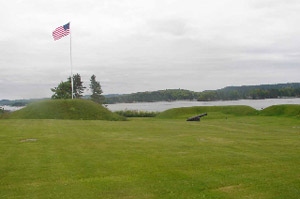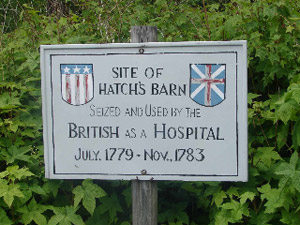 The beautiful bay was spread out before him, blue as the sky, with its dancing waves shining in the light of the rising sun, and, just coming into full view, sail after sail – ship after ship – brig – bark – transport – no one could tell how many – like a flock of white gulls coming in from the sea. Tom Seymour Photo The beautiful bay was spread out before him, blue as the sky, with its dancing waves shining in the light of the rising sun, and, just coming into full view, sail after sail – ship after ship – brig – bark – transport – no one could tell how many – like a flock of white gulls coming in from the sea. Tom Seymour Photo
|
The Scottish soldiers immediately fell to clearing land on a height above town and built Fort George. According to an article in the Hartford, Connecticut Times (date unknown), work on the fort and also “barracks, storehouses and earthworks along the shore at the foot of the hill,” continued non-stop until July 18. The peninsula was now officially occupied and also, fortified.
News of the occupation quickly reached Boston and the Massachusetts State Board of War received orders to organize an expedition against the British on the Penobscot. This was of such immediate import, that it was done without notifying the Continental Congress. There simply was no time. State leaders authorized the board to charter private vessels and to compensate the owners and pay crews the equivalent of what those enlisted in the Continental service earned. According to information included in the 2004 exhibit, “The Penobscot Expedition, 1779,” by the Castine Historical Society, the hastily-formed expedition boasted 18 armed vessels, 26 transports and 344 guns. Manpower included 1,150 militia and 200 marines (other sources variously list 19 armed vessels, 24 transports, 1,000 militiamen and 400 marines).
American Defeat
The American General Lowell commanded land forces, Con- tinental Navy Captain Dudley Saltonstall commanded naval forces and Lt. Colonel Paul Revere was placed in command of ordinance. An entry in Revere’s diary of July 25, 1779, reads, “We came to anchor close under Magabigwaduce about 3 o’clock in the afternoon. As we came up the bay, I could plainly see with my glass, the enemy had begun a fort, on one of the heights, in which was a long barrack; A number of men attempt to land under Brigr. Wadsworth; they approach the shore, orders are given for them to return; the enemy fired upon them and kill one Indian.”
After that, several landing attempts again failed, except that an attack on a British battery on Nautilus Island succeeded. The Americans built their own battery on the island’s heights and Lt. Colonel Revere armed it with ordinance ample to protect the entrance to the harbor. British Colonel McLean wrote, “The enemy having erected a battery on an island at the entrance of the harbor near our shipping, it became necessary for the men-of-war to remove higher up the river.”
During the pre-dawn hours of Wednesday, July 28, the American fleet stood off just out of musket range of the British. This was preparatory to their offensive action, which was accomplished by embarking on boats and landing at the foot of the peninsula’s western bluffs. The marines, leading the force, stormed the bluff and drove the British back to Fort George, losing 100 men out of 400 in the process.
The above-quoted article from the Hartford times mentions an interview with fifer Israel Trask. Years later, Trask re-visited the spot where the Americans landed and gave listeners a first-hand account of the action. Trask said that the attacking party divided into three parts, leaving one group on the beach to attract British musketry fire (a diversion), while the other two fought their way up the bluff, capturing a British battery. This in turn allowed the American fleet to move closer to shore, giving them a great advantage.
Another contemporary account by an unnamed American officer (from Wilson Museum Bulletin Number 4, Winter 1965), says, “From the enemy’s shipping there was – a stream of fire over our heads and a shower of musketry in our faces.” The fire over their heads came from the British ships, which had moved further up the harbor and were firing over land.
Stalemate Reigns
The victorious Americans drove the British back to Fort George. At this point, the unexpected occurred. Again according to Wilson Museum Bulletin Number 4, “Success seemed all but certain and the officers of the land forces wished to demand immediate surrender; this Commodore Saltonstall opposed, he also refused to send ashore more marines and threatened to recall those already entrenched.” So for two weeks, American forces built redoubts and batteries in an attempt to gain more ground and work their way closer to the fort.
At the same time, Commodore Saltonstall moved his ships out of harm’s way, despite what we must imagine were impassioned pleas from his officers to take advantage of his well-placed situation and attack the enemy ships. Finally, on August 13, General Lovell and Commodore Saltonstall began working in unison, with the purpose of using their combined resources to move against the British. But an hour into the effort, the Americans got word that a British naval squadron was approaching and indeed, was already in the bay.
A council of war concluded that it was impossible to beat the British in view of the approaching reinforcements. Ultimately, the American ships fled up the Penobscot River, where they were scuttled. Later, Saltonstall was court-martialed and forced out of the Continental Navy. Paul Revere received a censure. Revere protested and at his own request received a court-martial, where he was acquitted.
The “Penobscot Expedition” was by all accounts, one of the worst naval defeats in American history. Not until Pearl Harbor would America experience a similar defeat.
 General Gosselin, commanding British forces, landed his men and redcoats quickly filled town. The British quickly seized public buildings for use as barracks and additional structures were erected to house the British soldiers. General Gosselin, commanding British forces, landed his men and redcoats quickly filled town. The British quickly seized public buildings for use as barracks and additional structures were erected to house the British soldiers. Tom Seymour Photo
|
War Returns
The Revolutionary War finally ended, the St. Croix River, rather than the Penobscot became the boundary between the United States and Canada and loyalist dreams of a “New Ireland” in Maine were forever dashed. Many Tories left the region for good, to make a new life in the more hospitable Canadian Maritimes. In January 1784, the British Officer in command at Castine directed his men to fire the barracks and destroy whatever else they could, prior to evacuating.
During the post-war years, Castine enjoyed much peacetime prosperity and became an important center of commerce and shipbuilding. Castine also became the shire town of Hancock County. But with the advent of the War of 1812, tensions again rose along the coast of Maine in the face of a British blockading fleet. Then, on the morning of September 1, 1814, residents of Castine recoiled in horror at the sight of an invading, British fleet.
Wilson Museum Bulletin Vol. 3, No. 22, Spring 1991, contains a telling description of what a young boy, John Maynard Hale, witnessed on that fateful morning: “The beautiful bay was spread out before him, blue as the sky, with its dancing waves shining in the light of the rising sun, and, just coming into full view, sail after sail – ship after ship – brig – bark – transport – no one could tell how many – like a flock of white gulls coming in from the sea.”
This time, though, as opposed to when the British invasion during the Revolution, the American military had a presence at Castine. A half-moon earthwork, the Penobscot Battery (Fort Madison), was garrisoned by Lieutenant Lewis and about 40 men. The earthwork had four 24-pound guns and two field pieces. When the British demanded that he surrender the fort, Lt. Lewis spiked his guns (and according to A Brief History of Maine, Maine Historical Society, Portland, ME, 1890) and blew up the redoubt. Lewis and his men then headed up the river, away from Castine, to eventually fight the enemy in concert with a larger American force on the banks of the Penobscot River. For more on that topic, see The Invasion of Belfast, Fisherman’s Voice, Vol. 13, No. 10 – October 2008.
Occupied Castine
Having no recourse, town officials rowed out toward the British ships, carrying a flag of truce. Thus, General Gosselin, commanding British forces, landed his men and redcoats quickly filled the town. The British quickly seized public buildings for use as barracks and additional structures were erected to house the British soldiers.
The invader’s next action forever changed the geography of the peninsula. The soldiers were directed to dig a canal, in effect creating an island rather than a peninsula. The British Canal was ostensibly dug in order to reduce, or at least hinder, desertions from the garrison. It certainly would have but little effect upon invading American forces, since they would arrive by water rather than boat. But as it was, Castine sat out the remainder of the war as a town under foreign occupation. The Americans never came.
Today, historical markers abound in Castine, telling where the British had used a building as a barracks, a hospital, and so on. Additionally, burying grounds remain in pretty much their original condition.
The British left Castine, ironically enough, on April 15, 1815.
Modern Castine
After war’s end, Castine became an important shipping and boatbuilding port and remained so, up until railroads began to displace ships as a way of moving goods.
The Victorian era marked a “re-discovery” of Castine by vacationers from other states. These people built hotels, resorts and seasonal homes, places to spend quiet summers by the bay.
The preponderance of 18th and 19th-century homes, plus a healthy supply of American elms (these largely escaped the disease that ravaged elm trees in so many other American towns and cities) make Castine a continuing center of interest.
Other items of note include the Eastern State Normal School, built in 1867 and Maine Maritime Academy, with its training ship State of Maine.
|





